1975 Spanish Grand Prix race report
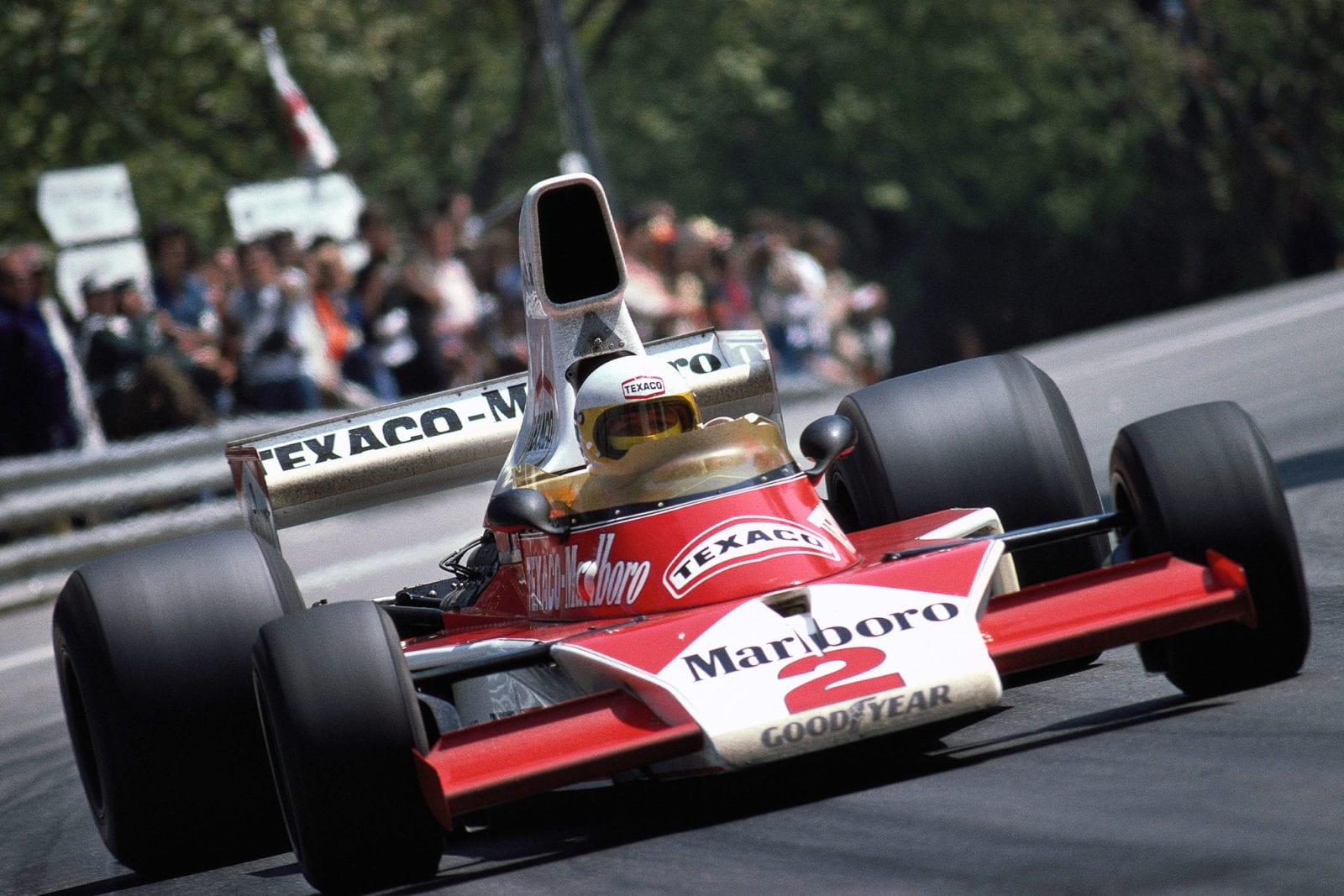
Jochen Mass emerged the victor from grand prix tainted by tragedy
Motorsport Images
Barcelona, April 27th
WE SHOULD have seen the writing on the wall when the transporters carrying the Formula One circus crossed the frontier into Spain with little or no trouble, unlike previous years when there had been long delays and muddles over paperwork. “Best trip we’ve ever had” said the UOP-Shadow crew. One man who did have a bit of bother was the driver of the Texaco “entertainment” caravan which was full of food and drink. The customs officials wanted assurance that it would all be taken out of Spain on the return trip and that nothing would be left behind. There was some delay caused by discussing the whys and wherefores of returning empty bottles and tins and in what form the food would probably be left in Spain!
The very scenic Montjuich Park was enveloped in Armco barriers and wire netting, the entire circus was ensconced in the big sports stadium just beyond the start area and Jean-Pierre Beltoise had made a flying visit to inspect the circuit for the Grand Prix Drivers Association a little while before. The sun was shining and everything seemed set for a superb Spanish Grand Prix on the exciting circuit on the very edge of the City, and enthusiasts from all over Europe were heading towards Barcelona to witness the opening of the European Grand Prix season. It was going to be a great occasion.
The first rumblings of discontent were heard coming from Switzerland where Emerson Fittipaldi had been heard to say that he was against racing on the Montjuich Park circuit as it was impossible to take adequate safeguards in the manner of Paul Ricard or Nivelles-Baulers, which was a sound enough statement of fact, like saying climbing a Swiss mountain was more dangerous than taking a walk through the English countryside! Previously at the Montjuich Park the paddock has been squeezed into the gardens behind the pits and many people had looked at the enormous Olympics sports stadium, built for the 1936 World Olympics but never used, as Spain decided to have a Civil War instead of an International sporting competition, wondering what it could be used for. This year the great rusty iron gates were opened and the transporters were ranged around the running track with more space than they knew what to do with. The Vel’s Parnelli Jones team were having to curb the enthusiasm of Mario Andretti who was eyeing the outer loose-cinder oval with a glint in his eye and saying “Just sprinkle a bit of water on it and it would make a great midget speedway, and we could use the Formula One cars.”
Qualifying
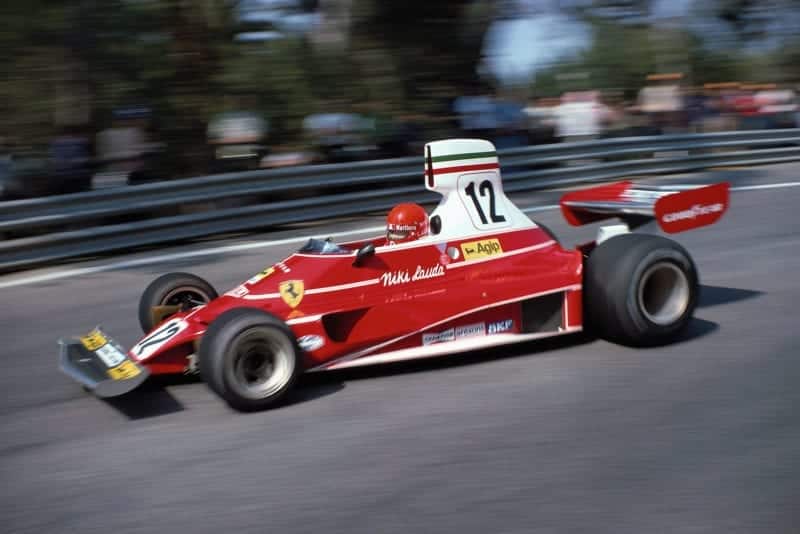
The Ferrari of Niki Lauda sat in pole position at the end of practice
Motorsport Images
Practice was due to start at the reasonable hour of 2 p.m. on Friday, April 25th, and all the teams were ready to go, the Texaco-Marlboro sponsored McLaren team had M23/9 and M23/8 ready for Fittipaldi and Mass, respectively, with M23/6 as a spare; the ELF Team Tyrrell had 007/2 for Scheckter and 007/4 for Depailler, with 007/5 as a spare; the John Player backed Team Lotus had 72/R9 for Peterson and 72/R5 for Ickx, with 72/R8 as a spare; the three Brabhams, sponsored by the Rossi family’s giant Martini empire, were B1, B2 and B3, for Reutemann, Pace and a spare in that order; March Engineering had the brand new car 751/3 for Brambilla in Beta Tools orange, and 751/2 for Lella Lombardi in white. The Scuderia Ferrari had three immaculate 1975 cars lined up in front of their transporter, all three with the transverse gearbox layout. Lauda had 022, Regazzoni 021 and 018 was the spare. Behind the cars was an equally impressive tool cabinet provided by Beta Tools. The Stanley family’s BRM team had two of their red, white and blue cars for Bob Evans to drive, P201/05 as the number one car with an engine with revised crankcase layout, and P201/02 as the spare car. Universal Oil Products Shadow team of wicked-looking black cars, with multi-coloured flashes on the nose fins and monocoque sides, were DN5/1A, 2A and 3A, for Jarier, Pryce and spare, respectively. They also had two neat little trolleys one for each driver, to carry a full set of wheels, jacks and wheel-nut spanners for emergency last-minute starting-line panics on tyre decisions. John Surtees’ Matchbox-supported team were running TS16/04-4 for John Watson, with /02-4 as a stand-by and a variety of nose cowlings and aerodynamic devices for experimentation. The Frank Williams team were in fine form, with a brand new car, FW/04, basically like the previous cars, but of new design in many details, such as cockpit shape, air-box, nose cowling, anti-roll bar layout, overall size and so on. The cockpit was much smaller than previous cars and the skinny Merzario was muttering that it was possibly “too small,” even for him. The other Williams car was FW/03, to be driven by Tony Brise, making his Formula One debut, going in at the deep end from Formula Atlantic, so to speak. Graham Hill was managing his Embassy-sponsored team of 1975 cars, built by his own small group, Stommelen having the latest car GH2 and Francois Migault being re-introduced to Formula One with the first Hill car, that started life as a Lola T371. Wrapped up in a canvas bag was one of the 1974 Lola cars as a spare in case of emergency. The small Hesketh team was looking quite large, and certainly very impressive, with 308/2 and 308/3 for James Hunt, both equipped with the Harvey Postlethwaite rubber-cone front suspension medium and the very forward extended front aero-foil. Alongside, in dark blue and advertising Harry Stiller’s enterprises and Rob Walker’s garages, was 308/1, similar to M’Lord’s cars, except for the rubber front suspension, it having the older coil-spring layout. Alan Jones was due to make his Grand Prix debut after a good showing in the International Trophy at Silverstone recently. The two American teams, by courtesy of English designers, were sparkling as usual, both having a pair of cars for their drivers, Andretti and Donohue, and while the Vel’s Parnelli Jones team are making very big forward strides, with Andretti a serious racer’s-racer, as ever, the Penske team, sponsored by First National City Travellers Checks, seem to be standing still. Poor Wilson Fittipaldi’s little team, sponsored by Brazil’s sugar industry seem to be the poor-relation in the circus, while Morris Nunn’s equally small one-car team looked very healthy, the once-green Ensign looking smart in white with the Dutch HB-alarms system colours and lettering on it, the Dutch driver Reolof Wunderink being responsible for the sponsorship.
Everything looked very good for the opening of the European season except that there were no drivers for they were all out on the circuit with Emerson Fittipaldi, pointing out that the guard-rails and debris-nets, while being in the right place, were badly fixed, many bolts being finger-tight and many missing altogether, while others were lacking plates under the heads to stop them pulling through the holes in the rails, and in some places the rails were not attached to the uprights. It was a case of shoddy workmanship, such as we have seen many times before on other circuits, The Formula One teams tend to think in air craft standards without realising that this involves aircraft standards of pay, and circuit amenities are usually put up by labourers working on labourers’ pay. Without doubt the steel barriers were sub-standard as regard their fixings, but instead of driving at sub standard speeds or personally explaining the situation to the paying public the drivers held a GPDA meeting in the Texaco caravan, gathering in the non-GPDA drivers as well and went on strike until something was done.
With five miles of double-row Armco in the Park and something like 500,000 bolts and fixings, instant-action was a bit unrealistic. Practice was delayed until 4 p.m. while the drivers talked among themselves and then Jacky Ickx, who is not a member of the GPDA, left the gathering saying that they were talking without saying anything. Donning his overalls he got into his Lotus 72 and put in some token laps at medium speed and later Vittorio Brambilla joined him for a lap or two. Many drivers were torn between their loyalties to their teams and to the GPDA, the new-boys wishing they could go racing without all this Union-business. Some of the teams, like Lotus, BRM and Shadow, had their cars in the pits, ready to go, while others, like Ferrari, Brabham and Hesketh, put their cars back in the paddock. Regazzoni would have liked to have got on with the job, but the Ferrari team-manager put the cars away and refused to become involved. Grand Prix practice fizzled out with only two drivers recording times, and then the local Formula SEAT 1800 single-seaters got on with their practice.
During the evening a small gang of workmen made a token attempt to rectify the faults, but the task was monumental and on Saturday Fittipaldi and Co. were still not satisfied and were calling for the race to be cancelled. At midday the small gang of labourers was greatly enhanced by an army of Formula One mechanics, team personnel, sponsors men and the likes of Ken Tyrrell, Colin Chapman and Max Mosely who were all saying “We want to get on with the racing, let’s get stuck in with spanners and do the job ourselves”. Which is exacly what they did. The drivers were still locked away behind smoked-glass windows, still talking without saying anything. The constructors and their work-force attacked the most crucial points on the circuit and the general feeling was that the circuit was 90% to CSI standards, and the FIA stewards accepted the circuit to be ready for racing. Practice was announced and Ickx, Bob Evans and Roelof Wunderink went out while the rest of the drivers remained hidden from sight, though there were those in their ranks who badly wanted to get on with the job. Bob Evans made the very reasonable observation that at one point he did not like the look of the installation of the guard-rails so on that section of the circuit he went slowly; elsewhere seemed to be alright.
Meanwhile the organisers and the team owners were getting their heads together, for all the teams had now accepted the circuit as adequate, though not perfect, doubting if it ever could be made perfect to the GPDA standards. While many of us view Grand Prix racing as a sport, it changed its status from a sport to a professional business in 1902, as Charles Jarrott pointed out in his classic book “Ten Years of Motors and Motor Racing”. Today it is as big a business as it has ever been, though the word “professional” is used loosely. The Formula One Constructors Association had made a contract with the Royal Club of Cataluna and it looked as though it was not going to be honoured. The consequences were very obvious for the whole circus was ensconced in the sports stadium and it would not have taken long to lock the gates and put a cordon of Guardia Civile round the place and impound the lot until legal retribution was taken. Some team managers were making open threats of cancelling contracts or reducing the financial inducements, while others went to the Texaco caravan to drag their drivers out by the hair, or anything else they could grab hold of. The whole affair had become so sick it was no longer funny and was yet another blow by the Trade Unions and the rising-up of the workers, as Karl Marx warned us would happen.
Four o’clock was the deadline and Colin Chapman was seen leading a very sheepish looking Ronnie Peterson down to the Lotus pit, where an expressionless Jacky Ickx was standing watching it all through dark glasses, but sticking to what he said at Zolder two years ago. “Mon metier, c’est pilote de course.” (My profession is racing driver.) One by one the drivers appeared in the pits, some with looks of relief on their faces, others looking very poker-faced, and last to appear was Emerson Fittipaldi who was greeted with whistles and cat-calls from the Spanish public in the grandstands, who seemed to be remarkably well informed of the dramas. Practice got under way on a very low note, but at least it was under way and it was not long before the “racer” instinct came out in Lauda, Hunt, Depailler and Andretti and the pace quickly warmed up to normal with the lap record of two years ago of 1 min. 23.8 sec. taking a battering, but not the 1973 pole-position time of 1 min. 21.8 sec. Reutemann, Pace and Merzario made no attempt to go racing while Emerson Fittipaldi went round so slowly, in protest, that he must have been a danger to the Laudas, Hunts and Andrettis who were having a bit of a go. The reigning World Champion was getting “the bird” from the Spanish public and someone reflected sadly that two years ago the same people were cheering him to the echo as he won the Spanish Grand Prix in a Lotus 72 with a flat rear tyre, after driving a heroic race.
The starting grid was made up from times recorded in this last opportunity for practice and just before it ended Depailler “lost” his Tyrrell and spun into the barriers, which did not fall down as some people predicted, but the rear of the car was damaged. There was a pause while the wrecked car was retrieved and Depailler continued in the spare Tyrrell. In the closing moments the time-keepers became confused by the two Ferraris running close together and recorded a false time for Regazzoni. Although a couple of the teams investigated it officially and the mistake was obvious on the time-sheets, it could not be proved, so Regazzoni was on the front row of the grid alongside Lauda, much to the joy of Ferrari enthusiasts. Hunt had the Hesketh in row 2 alongside Andretti’s Parnelli and both were portents not to be discarded lightly, while those two hard triers, Brambilla and Watson were in row 3.
Race
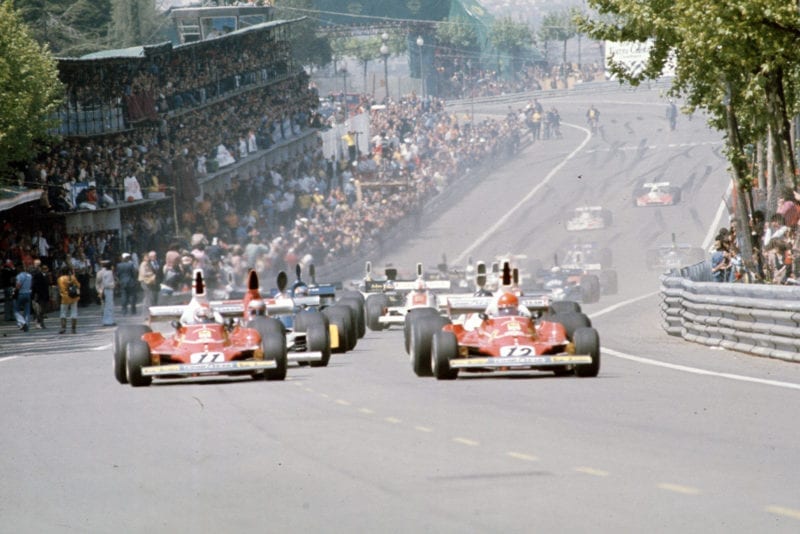
Lauda leads team-mate Regazzoni at the start
Motorsport Images
The clouds over the Montjuich Park cleared slightly on Saturday evening and workmen continued to check the safety barriers, so that on Sunday morning the stewards of the meeting were satisfied that all was well. Everyone was ready to take part except Emerson Fittipaldi and he had returned to his home in Switzerland saying that he considered the safety precautions “inadequate”, not that the circuit was dangerous. His brother Wilson and Merzario made it clear that they would drive but not race, and one or two others were still emotionally muddled, not sure what they were supposed to be doing. The start of the 75-lap race was supposed to have been at 12.30 hours, but a display of music and dancers in front of the main grandstand delayed things a bit, but eventually all was ready. The cars made a warm-up lap, lined up on the dummy-grid, and then Lauda and Regazzoni led them up to the start line. The 30-second signal was raised, but almost immediately the flag dropped and 25 cars made a superb start, with Lauda just leading Regazzoni up and over the brow of the hill leading to the first left-hand hairpin. Andretti was right with the Ferraris and Brambilla was going up the outside on the left. Down to the hairpin it all happened as Lauda braked late and heavily, trying to dive into the apex, but Andretti got his right-front nose-fin under a rear wheel of the Ferrari and was inadvertently pushing Lauda off line and into the path of Regazzoni’s Ferrari. Watson’s Surtees collided heavily with Andretti’s car and a lot of others were bouncing off one another. Hunt saw a gap in themelee and dived through into the lead, followed by Andretti, Watson, Stommelen and Brambilla and the rest followed, some bearing scars, while Lauda’s race was over with his right front suspension broken against the guard-rail and Regazzoni was limping along with a crumpled front and a smashed front wheel. He made it to the pits where a new nose-cowling was fitted and new front wheels and tyres and he joined in the race having lost four laps. Wilson Fittipaldi retired discreetly in the pits and Merzario gave up out on the circuit, but Hunt was really getting stuck in, but was not getting away from Andretti. The Parnelli car had its right-front nose-fin inoperative and its left rear wheel leaning in due to the top link inboard mounting having been bent on the first corner. As Andretti explained, “The two faults kinda evened each other out, and I soon learnt to live with the new handling, even though the car was crabbing on the straights”. John Watson was in a very healthy third place, followed by Stommelen in Graham Hill’s new car, Brambilla and Pace, while Peterson was catching them.
Hardly had the dust of the first lap settled than there were clangs and bangs as cars bounced off the guard-rails as if the GPDA were deliberately putting the safety-barriers to the test. Scheckter’s engine blew up in a big way and Jones spun his Hesketh out of the race on the resultant oil patch. Donohue did likewise and Reutemann had a spin which caused Wunderink to dodge and bang a rear wheel on the Armco, but he continued. After the Penske car had been removed from where it stopped, Hunt “lost” his Hesketh and the lead on the slippery surface and clanged to a stop against the rails and now Andretti was leading the race in the “out-of-line” Parnelli. All was going well for the little Italian and he led the race confidently, with Watson now in second place, trying hard to close on the American car. At one point the Irishman locked his left-front wheel under braking and unknowingly put a “flat” on the tyre and a little later when the front started to vibrate he thought a wheel-bearing was breaking up. At 11 laps he pulled into the pits for a check of the wheel-bearings and suspension and a lot of time was lost before the faulty tyre was discovered. This let Stommelen into second place with Pace and Peterson hard on his heels, for Brambilla had stopped to have his car checked as it felt odd and there was the thought he might have bent something in the first corner fracas. Jarier had also stopped to have a tyre changed and Evans was out with the drive to the fuel-injection unit on the BRM engine seized.
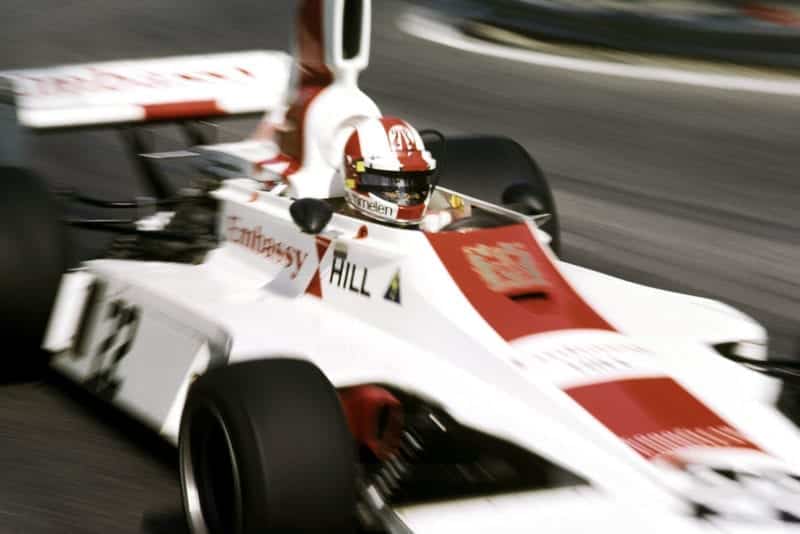
Stommelen before his fateful crash
Motorsport Images
Andretti’s gallant drive ended suddenly as the left-rear suspension link mounting, bent in the accident, now broke and let the wheel collapse, the car damaging itself on the steel barriers as it slid to rest. This left Stommelen in front, with Pace and Peterson now racing him for the lead, which was much more serious and Peterson began to make signs of forcing his Lotus past the Brabham. Down the field Brise had been leading Migault and Pryce, until the Frenchman damaged the nose of the Hill car and made a pit stop, and then the two young British drivers had a dice on their own. This ended when Brise hesitated coming out of a corner and Pryce ran the nose of his Shadow into the rear of the Williams. Brise stopped to inspect for damage and the Shadow had its nose cowling bent and the oil cooler inside it was rubbing on the road. On lap 24 the leading trio were lapping Migault, who had rejoined the race, and as they went into a corner there was room for the first two to go by but not the third, and Peterson collided with the Hill car and bounced into the barriers, breaking a front suspension link bolt, which left the Lotus leaning on its elbow. Jochen Mass was now third and Ickx fourth, followed by Reutemann and Jarier.
Stommelen was still leading as he started lap 26, with Pace right on his tail, and the two cars went by the pits and up the hill past the paddock stadium at 150 m.p.h. The road up the hill is a long left curve as it approaches the brow, where the cars are almost air-borne and without warning the rear aerofoil parted company from Stommelen’s car. With a left bias already on the car, the instant removal of all down-thrust on the rear wheels caused it to veer across the road and hit the barriers on the left. They did not collapse, as predicted, but stood firm and deflected the car across the road at something like 130 m.p.h. and Pace braked furiously to avoid it but the Brabham was nudged into the barriers and careered down the hill smashing wheels as it went. Stommelen’s car continued on its natural horizontal path from its point of contact on the left, but by sheer bad luck this path was across the brow of the hill, so that when it reached the barriers on the right, they and the road surface were already at a lower level so that the crashing car skated along the top rail, took down a lamppost and a length of wire debris net as it destroyed itself. The car had not been launched up in the air by the left-hand rails as some people said, nor had the right-hand rails collapsed. In fact, all round the circuit the guard-rails had been tried and tested and not found wanting. Miraculously, Stommelen was still alive, but with many broken bones but a fire-marshal and four other people were killed, while some nine or ten were injured.
When the extent of the injuries was ascertained there was nothing to be done except stop the race, principally in order to get ambulances and a breakdown truck to the scene of the accident. This catastrophe left Mass in the lead with Ickx second and the Belgian passed the McLaren on lap 28, but was re-passed on lap 29 at which point the chequered flag was out and the whole unfortunate affair of the Spanish Grand Prix 1975 was over. By the FIA rules it could have been restarted again, but in view of the seriousness of the accident the Spanish Grand Prix was declared finished at 29 laps.
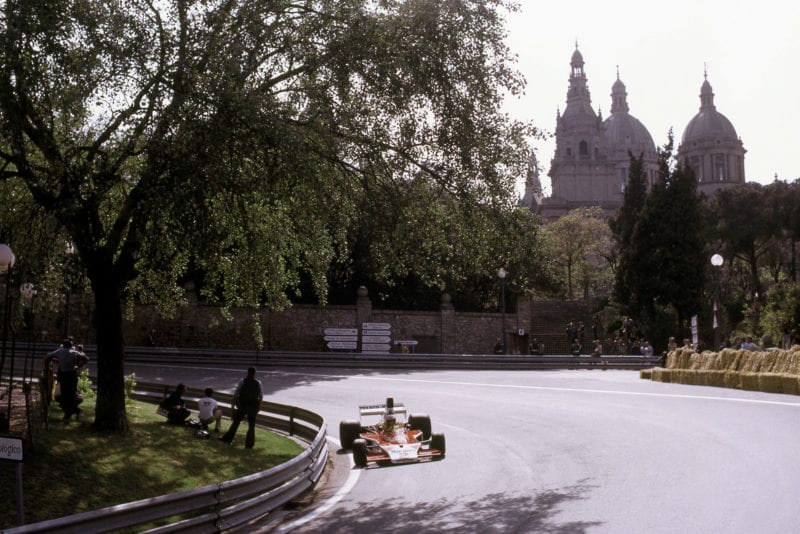
Mass won the halted race with half points awarded
Motorsport Images
From far-away Switzerland came cries of “I told you so” while the media men disported themselves in all stages from the philosophical to the hysterical. A lot of people reflected on the whole situation and the position that the extrovert human being holds in society, whether he races cars, motorcycles, powerboats, aeroplanes or merely spectates at these activities, or whether he explores holes in the ground, climbs mountains, scans the bottom of the sea, tries to fly like a bird, or fights bulls. The extrovert, whether he be participant or spectator, knows the risks and accepts them, the peace-loving citizen who is beaten up by hooligans and yobs in cities or at football matches not only needs our sympathy but also our help.—D.S.J.
SPANISH GRAND PRIX – Formula One – 29 laps – Montjuich Park, Barcelona
3.79 kilometres per lap – 109.9 kilometres – Warm and dry
1st:J. Mass (McLaren M32/8)………………..42 min. 53.70 sec.153.764 k.p.h (race stopped prematurely)
2nd:J. Ickx (Lotus 72/R5)……………………..42 min. 54.80 sec.
3rd:C. Reutemann (Brabham BT44B/1)…….43 min. 44.80 sec.
4th:P-P. Jarier (Shadow DN5/1A)…………………1 lap behind
5th:V. Brambilla (March 751/3)…………………….1 lap behind
6th:L. Lombardi (March 751/2)……………………..2 laps behind
7th:A. Brise (Williams FW/03)………………………2 laps behind
8th:J. Watson (Surtees TS16/04-4)……………….3 laps behind
9th:G. Regazzoni (Ferrari 312B3/021 (T2))………4 laps behind
10th:F. Migault (Hill GH1 (HU371/1))……………..11 laps behind
Fastest Lap: M. Adretti (Parnelli VPJ4/002) on lap 14, in 1 min. 25.10 sec. – 160.356 k.p.h.
retirements:N. Lauda (Ferrari 312B3/022 (T3)) accident, on lap 1; W. Fittipaldi (Fittipaldi FD/02) withdrew, on lap 2; A. Merzario (Williams FW/04) withdrew, on lap 2;, P. Depailler (Tyrrell 007/4) result of accident damage on lap 2; M. Donohue (Penske PC1/02) accident on lap 4; A. Jones (Hesketh 308/1) accident, on lap 4; J. Scheckter (Tyrrell 007/2) engine broke, on lap 4; J. Hunt (Hesketh 308/2) accident, on lap 7; R. Evans (BRM P201/05) injection pump drive failure, on lap 8; M. Andretti (Parnelli VPJ4/002) broken suspension as result of earlier accident, on lap 17; R. Wunderlink (Ensign N175) broken drive shaft as result of earlier accident, on lap 21; T. Pryce (Shadow DN5/2A) damaged nose cowling and oil cooler, on lap 24; R. Peterson (Lotus 72/R9) damaged front suspension, on lap 24; R. Stommelen (Hill GH2) accident, on lap 26; C. Pace (Brabham BT44B/2) accident, on lap 26
25 starters – 10 finishers
